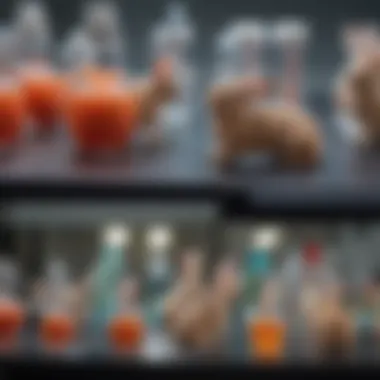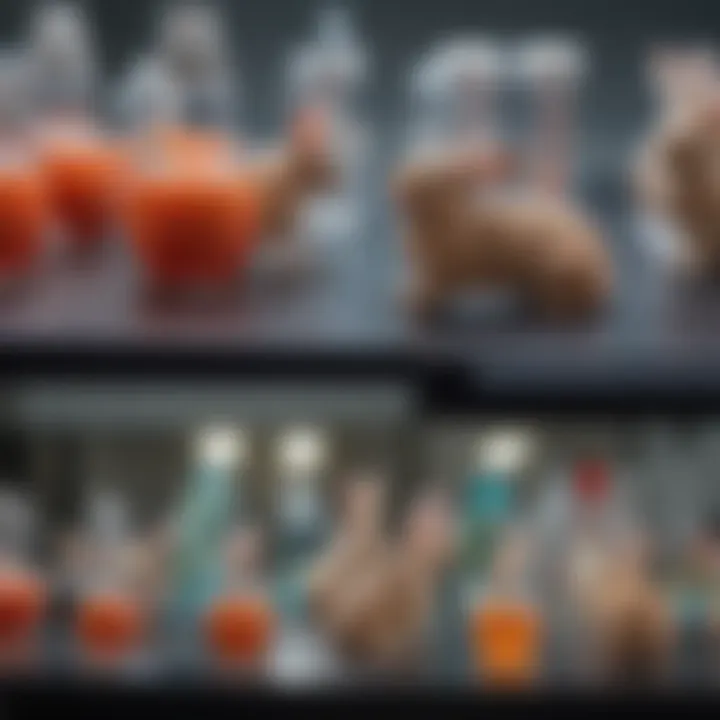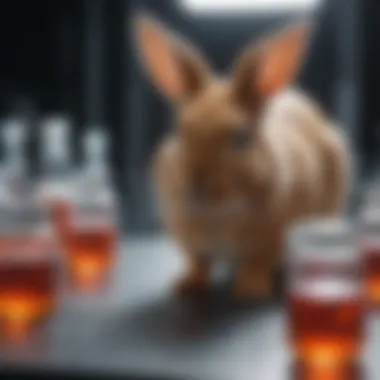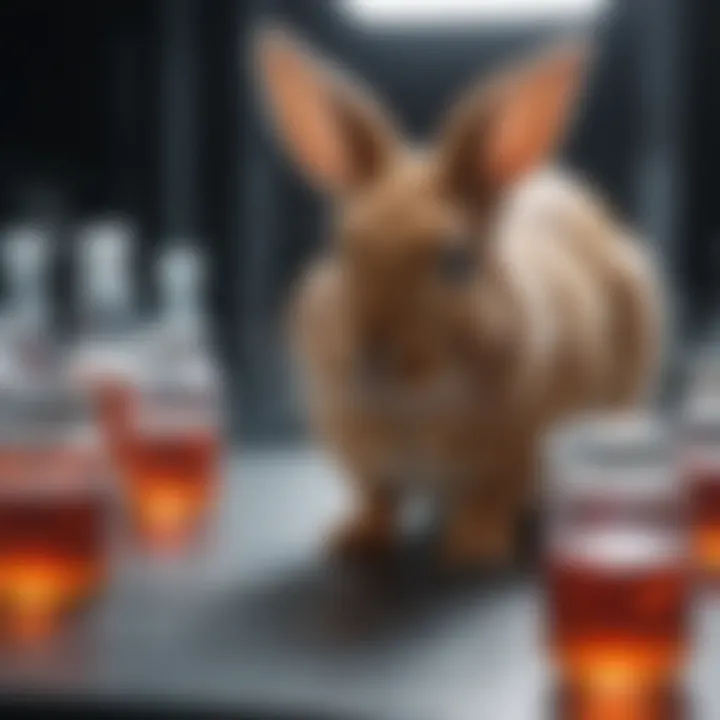Rabbit Monoclonal Antibody Production Techniques


Intro
Rabbit monoclonal antibodies have emerged as a significant asset in the fields of research and clinical diagnostics. These antibodies, known for their high specificity and affinity, are produced through an intricate series of processes that leverage the unique biological responses of rabbits. As scientists and medical professionals strive for accuracy in disease detection and treatment, understanding the techniques behind rabbit monoclonal antibody production becomes increasingly relevant. This article aims to elucidate the various methodologies involved, highlight the challenges faced, and articulate the significance of these antibodies in both laboratory and clinical settings.
Preamble to Monoclonal Antibodies
Monoclonal antibodies stand as a cornerstone in modern biochemistry and medical research. Their ability to specifically target antigens has revolutionized diagnostics, therapeutics, and a variety of experimental applications. The effective use of these antibodies can lead to breakthroughs in treating diseases, understanding immune responses, and enhancing the reliability of laboratory assays. This article delves into rabbit monoclonal antibody production, which showcases a unique approach in an already complex field, highlighting the benefits and techniques unique to this method.
Definition and Types
Monoclonal antibodies are antibodies that are identical because they are produced by immune cells that are all clones of a unique parent cell. The specificity of monoclonal antibodies allows them to target specific antigens, making them highly valuable in both research and therapeutic applications. There are two primary types of monoclonal antibodies:
- Murine Monoclonal Antibodies: These are produced from mouse cells and often face issues like immunogenicity in human applications.
- Chimeric and Humanized Antibodies: These are engineered to reduce immunogenicity by combining mouse and human antibody sequences.
- Rabbit Monoclonal Antibodies: Gaining ground in recent years, rabbit monoclonal antibodies boast superior specificity and affinity compared to murine counterparts.
Overall, the choice of monoclonal antibody type can significantly influence research outcomes and therapeutic effectiveness.
Rabbit vs. Mouse Monoclonal Antibodies
In the ongoing discourse over the optimal source of monoclonal antibodies, rabbit monoclonal antibodies have emerged as an exciting alternative to their mouse counterparts. Production methods differ greatly, and each has its own advantages and disadvantages.
- Higher Specificity: Rabbit antibodies show enhanced specificity due to the larger repertoire of immune cells and unique immune responses present in rabbits. This results in the production of antibodies that are less likely to cross-react with non-target proteins.
- Affinity Binding Properties: The binding affinity of antibodies crafted from rabbits tends to be higher, which is critical for applications like immunohistochemistry or targeted therapies where precision is key.
Additionally, rabbit models can often mount stronger immune responses than mice, making them a preferable choice for generating high-quality antibodies. This evolving field continues to gain traction among researchers, as advancements in technology further facilitate rabbit monoclonal antibody production.
"A shift towards rabbit monoclonal antibodies could redefine specificity and availability in research, bringing us closer to better diagnostic tools and therapeutics."
"A shift towards rabbit monoclonal antibodies could redefine specificity and availability in research, bringing us closer to better diagnostic tools and therapeutics."
In sum, the exploration of rabbit monoclonal antibodies demonstrates the ongoing innovation in biomedical research, driving an era where enhanced specificity, higher affinity, and reduced variability in antibody responses are within reach.
The Significance of Rabbit Monoclonal Antibodies
Rabbit monoclonal antibodies are carving a niche for themselves in the realm of research and therapeutic applications. Their distinct advantages make them particularly significant in various scientific fields. Unlike their mouse counterparts, rabbit-derived antibodies often exhibit higher affinity and specificity, providing researchers with tools that can effectively target a wide array of antigens. This section illuminates the advantages that set rabbit monoclonal antibodies apart, delving into their enhanced specificity and higher affinity binding.
Enhanced Specificity
An essential aspect of rabbit monoclonal antibodies is their enhanced specificity. When we talk about specificity, we’re looking at how accurately an antibody can bind to its target antigen without cross-reacting with similar molecules. Rabbit antibodies tend to have a broader spectrum of response, which means they can recognize more varied epitopes compared to mouse antibodies. This is especially crucial in experiments where precision is key, such as in diagnostic assays or research involving complex biological systems.
For instance, in studies focusing on human disease markers, the nuanced differences in antigen epitope recognition can lead to improved diagnostic accuracy. Researchers have found that using rabbit monoclonal antibodies allows for cleaner results in immunohistochemistry, resulting in minimal background staining compared to those obtained with mouse monoclonals. Ultimately, this heightened specificity not only boosts experimental reliability but also aids in understanding biological interactions at a granular level.
Higher Affinity Binding
Following closely on the heels of specificity is the concept of affinity. The term refers to the strength at which an antibody binds to its target antigen. Rabbit monoclonal antibodies generally show a higher affinity for their antigens. This characteristic allows for the detection of their targets in significantly lower concentrations. As a result, assays that utilize rabbit antibodies can often be carried out with less sample material, which is an invaluable asset when working with rare or precious samples.
To illustrate this, consider the context of early disease detection. When trying to identify a biomarker present at low levels in a patient’s blood, having an antibody with high affinity could make all the difference. It increases the chances of successfully capturing the target during assays, yielding more reliable diagnostic results. Furthermore, this high-affinity binding can enhance the effectiveness of therapeutic applications, potentially leading to better treatment outcomes.
"Higher affinity can translate to lower detection limits, allowing for more sensitive and specific assays, crucial in the early diagnostics of diseases."
"Higher affinity can translate to lower detection limits, allowing for more sensitive and specific assays, crucial in the early diagnostics of diseases."
The advantages of rabbit monoclonal antibodies open new doors for exploration in both clinical and research landscapes. Their enhanced specificity and higher binding affinity not only improve the quality of scientific results but also underscore their growing importance in modern biotechnological applications.
Overview of the Production Process
The production process of rabbit monoclonal antibodies is a complex yet essential topic, laying the foundation for the successful implementation of these antibodies in various fields such as research and clinical diagnostics. The methodologies encompassed within this overview provide insight into the meticulous steps involved, emphasizing not just technical aspects but also the importance of each phase in ensuring high-quality output. Understanding this process is crucial for researchers and practitioners aiming to leverage rabbit monoclonal antibodies effectively.
Immunization Techniques
Immunization serves as the starting point for generating rabbit monoclonal antibodies. This process usually involves introducing an antigen into the rabbit's body, stimulating its immune system to respond. A successful immunization technique hinges on several factors:
- Choice of Antigen: The type and purity of the antigen are pivotal. A well-characterized antigen is more likely to elicit a strong immune response. For instance, using a complex protein rather than a simple peptide can enhance the overall efficacy of the response.
- Route of Administration: The method of administering the antigen—subcutaneous, intramuscular, or intravenous—can influence the immune response. Often, a combination of routes is employed for optimal results.
- Adjuvants: Incorporating adjuvants can significantly boost the immune response. Adjuvants like Freund's complete adjuvant and AS03 amplify the immune system's reaction to the antigen, leading to better antibody yields.
By carefully tailoring these immunization techniques, researchers can optimize the generation of robust antibodies that specifically target their desired antigens.
Cell Fusion and Hybridoma Technology
Once the rabbit's immune system has been adequately stimulated, the next crucial stage involves the fusion of the activated lymphocytes with myeloma cells to create hybridomas. This hybridization process enables the creation of a cell line capable of producing monoclonal antibodies indefinitely. Here are the key considerations:
- Preparation of Myeloma Cells: Selecting the right myeloma cell line is vital. For rabbit hybrids, specific rabbit myeloma cells are often selected to ensure compatibility and optimal fusion efficiency. The cells must also be made non-immunogenic to prevent host rejection.
- Fusing Lymphocytes with Myeloma Cells: The fusion itself is typically conducted using polyethylene glycol (PEG), a reagent that encourages the merging of the cell membranes. This step is delicate and must be conducted under precise conditions to maximize yield. Commonly, a 1:1 ratio of myeloma to lymphocyte cells is used to enhance the likelihood of producing hybridomas that produce strong antibody responses.
Through these stages, researchers can create a consistent supply of antibodies with specific binding capabilities, markedly enhancing the efficiency of antibody generation compared to traditional methods. The careful orchestration of these processes is fundamental in producing reliable and high-affinity monoclonal antibodies, which ultimately contribute to advancements in various scientific domains and therapeutic interventions.
Immunization Protocols
Immunization plays a pivotal role in the production of rabbit monoclonal antibodies. Proper immunization protocols significantly enhance the yield and specificity of antibodies produced by rabbits, ensuring that they effectively target the intended antigens. By fine-tuning these protocols, researchers can optimize the immune response of the rabbits, tailoring it to generate antibodies that exhibit high affinity and specificity.
Adjuvants Selection
The selection of adjuvants is crucial in the immunization process. Adjuvants are substances that enhance the body’s immune response to an antigen. Choosing the right adjuvant can mean the difference between a mediocre antibody response and a robust one.
For instance, Freund's complete adjuvant is widely used due to its ability to produce a strong immune response. However, some scientists prefer alternatives like Montanide or MPL because they are less likely to induce prolonged reactions at the injection site. The choice often depends on the specific requirements of the study and the nature of the antigen involved.
Also, it's essential to balance the potency of the adjuvant with its safety, ensuring minimal discomfort or adverse reactions in the rabbit.
Dosage and Scheduling
The dosage and scheduling of immunizations are another layer of complexity in terms of protocols. A well-structured immunization schedule can facilitate the development of desired antibodies, maximizing both quality and quantity.
Typically, initial doses are administered to provoke the immune system, followed by booster shots to reinforce the immune memory. The intervals between these doses can greatly influence the production efficiency.
For example, administering boosters too early may not allow sufficient antibody development; too late, and the immune response may wane. Achieving the ideal timing calls for meticulous planning. Here are a few considerations that help improve efficacy:
- Initial Dose: Start with a higher dose to kickstart the immune response.
- Booster Shots: Follow-up doses should be carefully timed—commonly range from 2-4 weeks after the initial dose.
- Monitoring: Regularly check for antibody levels post-immunization. This data assists in adjusting future doses or timing as needed.
"Understanding the nuances of immunization protocols is akin to fine-tuning an exquisite instrument; each adjustment improves the overall performance of the system."
"Understanding the nuances of immunization protocols is akin to fine-tuning an exquisite instrument; each adjustment improves the overall performance of the system."
Cell Fusion Mechanisms


Cell fusion is a critical element in the production of monoclonal antibodies, especially when working with rabbits. The merging of different cell types offers a method to combine the beneficial traits of both parent cells, effectively generating hybrid cells known as hybridomas. This process results in cells that can produce antibodies in large quantities while maintaining high specificity. The significance of understanding cell fusion mechanisms cannot be overstated; it is the cornerstone of generating effective monoclonal antibodies that advance research and clinical applications.
Preparation of Myeloma Cells
The first step in the fusion process involves preparing myeloma cells. These are cancerous B cells that have been genetically modified to make them immortal. Their ability to replicate indefinitely provides a continuous source of antibody production. However, these cells must also be primed to allow for successful fusion with lymphocytes. Often, this is achieved by subjecting myeloma cells to specific treatments that alter their membrane characteristics, making them more receptive to fusion.
Key Points in Preparation:
- Cell Line Selection: Choosing the right myeloma cell line is crucial. For instance, the SP2/0 line is commonly used due to its low immunoglobulin production, creating a better environment for hybridoma development.
- Culture Conditions: The environments where myeloma cells are cultured—often in RPMI media with serum—must be optimized to maintain cell health and viability.
Taking time to meticulously prepare these cells pays off in the fusion phase, where strong, stable hybridomas can be developed.
Fusing Lymphocytes with Myeloma Cells
Once myeloma cells are prepared, the next step is to fuse them with lymphocytes, typically derived from an immunized rabbit. This procedure usually employs a fusion agent, such as polyethylene glycol (PEG), which helps the two cell types merge effectively. The significance of this step is enormous. A successful fusion yields hybridomas capable of producing specific antibodies against the target antigen, a pivotal aspect of generating effective monoclonal antibodies.
Important Considerations:
- Optimal Fusion Conditions: Fusions should occur in a carefully controlled environment, as temperature, pH, and media conditions can drastically affect outcomes.
- Lymphocyte Preparation: Just like myeloma cells, lymphocytes must be in the best shape possible. Ensuring they possess high functional activity—meaning they are reactive to the specific antigen—is vital for achieving fruitful fusion results.
The efficiency of lymphocyte fusion significantly influences the yield and specificity of the produced monoclonal antibody, directly affecting research and clinical outcomes.
The efficiency of lymphocyte fusion significantly influences the yield and specificity of the produced monoclonal antibody, directly affecting research and clinical outcomes.
Selection of Hybridomas
The selection of hybridomas is a pivotal step in the production of rabbit monoclonal antibodies, linking the initial immunization phase with the final antibody harvest. This stage is fundamentally about finding and isolating those cells that generate antibodies specific to a chosen antigen. The effective selection of hybridomas not only ensures the quality of the resulting antibodies but also optimizes the yield, thereby making the entire production process more efficient.
Screening Techniques
Screening techniques vary widely, but they are all aimed at identifying hybridoma clones that produce the desired monoclonal antibody. Generally, a multi-step approach is utilized. The initial step often involves a functional assay where hybridomas are cultured in a medium containing the target antigen. Those hybridomas that bind to the antigen will survive while others will perish due to stringent culture conditions.
Moreover, advanced technologies like ELISA (Enzyme-Linked Immunosorbent Assay) and FACS (Fluorescence-Activated Cell Sorting) are frequently employed to enhance the screening process. ELISA provides a high-throughput method for assessing the binding affinity, while FACS allows for the sorting of hybridomas based on fluorescent tags, which can be directly linked to antibody production potentially streamlining the identification of high-producing clones.
Key benefits of these screening techniques include:
- Increased specificity: Reducing cross-reactivity ensures that the clones selected are truly representative of the intended monoclonal class.
- Time and resource saving: Automating the selection process enables researchers to allocate resources on other essential aspects of research and development in their labs.
Screening techniques remain critical when addressing the overall productivity of antibodies. Each method contributes, in its own way, to a more precise selection process, ultimately influencing the performance of the resultant monoclonal antibodies.
Cloning Strategies
After identifying potential hybridomas, the next hurdle is to focus on cloning those selected cells. Cloning strategies are essential for establishing a uniform population of hybridomas that consistently produce the same monoclonal antibodies. Typically, this is executed by either limiting dilution or the use of semi-solid media, allowing each cell to grow in isolation.
Limiting dilution can effectively reduce the number of starting cells, promoting the growth of single-cell-derived colonies, while semi-solid media serve as a scaffold that supports growth and differentiation. It's noteworthy that both approaches have their merits and setbacks.
- Limiting dilution:
- Semi-solid media:
- Pros: Simplicity in technique and direct monitoring of individual colonies.
- Cons: Lower success rate in achieving single-cell colonies, which may lead to exhaustion.
- Pros: Increases the chances of clonally deriving hybridomas and managing growth in a more stable environment.
- Cons: More complex procedures and potential for reduced viability if conditions are not ideal.
Ultimately, a robust cloning strategy enhances the reliability of antibodies produced. By focusing on methods that decrease cross-reactivity and increases purity, researchers can ensure their monoclonal antibodies are both effective and applicable across multiple settings—be it research or clinical applications.
The reliability of hybridomas selected through rigorous screening and cloning strategies can greatly influence the success of downstream applications in both research and therapeutic contexts.
The reliability of hybridomas selected through rigorous screening and cloning strategies can greatly influence the success of downstream applications in both research and therapeutic contexts.
In summary, crafting a coherent plan around the selection, screening, and cloning strategies of hybridomas contributes significantly to the overall efficiency and efficacy of rabbit monoclonal antibody production.
Antibody Production and Harvesting
Antibody production and harvesting stand as cornerstone activities in the realm of monoclonal antibody research, particularly when focusing on rabbit models. This process is not just a routine task; it's a delicate dance that requires precision and a deep understanding of cellular behavior. The significance of producing high-quality antibodies cannot be overstated—it influences downstream applications in both research and clinical environments. One has to consider not only the yield but also the purity and functionality of the antibodies harvested.
As researchers embark on this journey, various factors come into play. Attention must be given to growth factors, nutrient medium, and environmental conditions during cell culture. These conditions ensure that the hybridoma cells thrive and generate antibodies effectively. A successful antibody harvesting protocol merges both art and science; optimizing each detail can mean the difference between mediocre and exceptional antibody yields.
"The journey of antibody production is as significant as the end product itself. Each step taken in the process lays the foundation for the efficacy and applicability of the antibodies produced.”
"The journey of antibody production is as significant as the end product itself. Each step taken in the process lays the foundation for the efficacy and applicability of the antibodies produced.”
Culture Conditions
Culture conditions are fundamental in the life cycle of hybridoma cells. Maintaining an environment conducive to growth is paramount. Temperature, pH, and oxygen levels must be tightly controlled. Typically, hybridomas fare well in an incubator set to 37°C, ensuring optimal growth. The addition of supplements like fetal bovine serum can greatly enhance cell proliferation and viability, providing essential nutrients and growth factors.
Moreover, the choice of culture medium also plays a crucial role. Simplistically, these media are categorized into serum-free and serum-containing; the former tends to lead to more consistent results, albeit with higher initial costs. It is wise to adapt culture conditions based on the specific requirements of the monoclonal antibodies being produced, as some may require specialized media to reach their highest potential.
Key Considerations in Culture Conditions:
- Temperature Control: Standard setting around 37°C
- Nutrient Medium Selection: Serum-free vs. serum-containing
- Oxygenation Levels: Ensuring adequate gas exchange to promote cell health
Scaling Up Production
When it comes to scaling up production, one step leads to another. After fine-tuning laboratory-scale cultures, researchers often face the challenge of moving to larger bioreactors. This leap isn't as simple as just increasing the volume of culture medium; it introduces complexities such as nutrient flow, waste removal, and maintaining consistent culture conditions.
Progressing from benchtop to bioreactor demands careful consideration of several factors, including:
- Batch vs. Continuous Culture: Each method comes with advantages and potential pitfalls, influencing how antibody production is managed.
- Bioreactor Design: The architecture of bioreactors can significantly affect nutrient access and growth uniformity, necessitating detailed planning.
- Monitoring Systems: Real-time assessment of pH and dissolved oxygen levels is vital to ensure optimal growth conditions during scaling.
In constructing a scalable system, many organizations turn to technology like automated systems that can monitor and adjust conditions in real-time, enhancing resource efficacy and minimizing human error.
Ultimately, scaling up production isn't merely about increasing quantity; it’s about maintaining quality. As witnessed throughout the various phases of antibody production, the focus must remain on generating high-quality, effective antibodies that are prepared for any application—be it in research or clinical trials.
Purification Methods
Purification methods are a cornerstone in the realm of monoclonal antibody production. This segment highlights the essential techniques utilized to isolate, purify, and stabilize rabbit monoclonal antibodies, ensuring both their efficacy and safety for subsequent applications. The significance of these methods cannot be overstated, as the quality of antibodies directly impacts research outcomes and clinical therapies.
Effective purification not only removes contaminants but also enhances the specificity and potency of antibodies. When embarking on the purification journey, scientists must consider factors like yield, purity, and functionality, which form the bedrock of successful antibody utilization. Key purification techniques include affinity chromatography and precipitation techniques, both of which will be discussed in detail.
Affinity Chromatography


Affinity chromatography stands out as a widely used technique for purifying antibodies. This method leverages the specific interactions between an antibody and its target ligand, allowing for high selectivity during the purification process. The approach typically involves these steps:
- Column Preparation: A chromatographic column is packed with a solid support, usually beads that contain the ligand to which the antibody will bind.
- Sample Application: The supernatant containing the crude antibodies is then loaded onto the column. As the solution passes through, antibodies will bind to the ligand, while non-specific proteins and impurities are washed away.
- Elution: After washing, bound antibodies are eluted using a buffer that disrupts the interaction between the antibodies and the ligand, allowing for recovery.
The benefits of affinity chromatography are manifold:
- High Purity: This method efficiently separates antibodies from a wide range of contaminants, leading to a high-quality product.
- Scalability: It can be scaled up efficiently from laboratory bench to production scales, making it versatile for different applications.
- Flexibility: Various ligands can be used to target specific antibodies, enhancing the specificity of the process.
However, it is essential to be aware of potential considerations such as loss of antibody functionality during elution and the requirement for optimized binding and elution conditions.
Precipitation Techniques
Precipitation techniques offer another avenue for antibody purification, often employed as a preliminary step before more refined processes like affinity chromatography. This method relies on the solubility differences of various proteins and can be achieved through chemical means using salts like ammonium sulfate or via pH changes.
In typical scenarios, the following steps are undertaken:
- Adding Precipitant: A precipitant is added to the antibody solution, leading to the formation of insoluble complexes.
- Centrifugation: Following incubation, centrifugation is employed to separate the precipitated antibodies from the supernatant.
- Washing: The precipitated antibodies are washed to remove contaminants and residual precipitant.
The advantages of precipitation techniques include:
- Cost-effectiveness: Compared to affinity chromatography, precipitation methods can be more economical.
- Simplicity: The protocols are straightforward, requiring less specialized equipment.
- Initial Purification: Acts as an effective initial step before more involved procedures, allowing for a concentration of antibodies without extensive processing.
Nonetheless, an important note here is the trade-off between speed and purity. While useful, precipitation may not yield as pure a product as affinity chromatography, necessitating subsequent purification for high-stakes applications.
“In the world of antibody production, choosing the right purification method can be the difference between success and a costly failure.”
“In the world of antibody production, choosing the right purification method can be the difference between success and a costly failure.”
In summary, purification methods such as affinity chromatography and precipitation techniques each have their strengths and weaknesses. The choice of which to utilize often depends on the specific requirements of the project, including budget constraints and desired antibody quality.
Characterization of Monoclonal Antibodies
Characterization of monoclonal antibodies is a cornerstone in the understanding and application of these biotechnological marvels. In the landscape of rabbit monoclonal antibody production, this process plays a critical role in ensuring that the antibodies are suitable for their intended applications. It encompasses a range of evaluations, from assessing the purity of antibodies to understanding their binding properties and specificity. Effective characterization enhances the consistency and reliability of research findings and clinical outcomes.
Assessing Specificity
Specificity refers to the ability of an antibody to bind to a particular target antigen without cross-reacting with other substances. This quality is paramount in both research settings and clinical applications, where the wrong binding can lead to erroneous results or adverse effects in therapies. To assess specificity, various techniques can be deployed, including:
- Enzyme-Linked Immunosorbent Assays (ELISA): This widely used method allows for the detection and quantification of antibodies in a sample. By applying known antigens and measuring the binding of antibodies, researchers can infer specificity effectively.
- Western Blotting: After gel electrophoresis, this technique uses specific antibodies to determine if the target protein is present, providing insights into the antibody's specificity.
- Immunohistochemistry: Using tissue samples, this method helps visualize the location of specific proteins, thus demonstrating how well the antibody distinguishes its target from similar proteins.
Each of these methods has its strengths and can be chosen based on the specific requirements of the experiment or clinical application. In addition, developing control experiments is essential to validate that the observed binding is indeed specific.
Determining Affinity
Affinity relates to the strength with which an antibody binds its antigen. High-affinity antibodies are desired in many applications, as they tend to be more effective in both research and therapeutic contexts. Affinity can be determined through several approaches:
- Surface Plasmon Resonance (SPR): This real-time analysis allows the measurement of kinetics and affinity of antibody-antigen interactions, making it one of the most accurate methods available.
- Biolayer Interferometry: Similar to SPR, this label-free technique measures the interference patterns of light to evaluate binding interactions, providing insight into affinity metrics.
- Kinetic Assays: These involve assessing the association and dissociation rates of the antibody-antigen complex to derive the overall affinity, usually expressed as the equilibrium dissociation constant (Kd).
Affinity assessments not only inform the effectiveness of the antibodies but also guide optimization in production protocols, potentially enhancing yield and specificity.
"Quality control is the backbone of successful monoclonal antibody production; without thorough characterization, the journey ends without proper efficacy or safety."
"Quality control is the backbone of successful monoclonal antibody production; without thorough characterization, the journey ends without proper efficacy or safety."
In sum, the characterization of monoclonal antibodies, especially those derived from rabbits, is an intricate blend of specificity and affinity evaluations. This process allows for the selection and application of the right antibodies in both research and clinical realms, addressing pertinent issues like sensitivity and usability. Understanding these elements enriches the scientific dialogue and pushes forward the frontiers of biomedicine.
Quality Control Measures
Quality control measures are crucial in the production of rabbit monoclonal antibodies, ensuring that every antibody produced meets the required standards for specificity, efficacy, and safety. Focusing on these measures not only boosts the quality of the antibodies themselves but also enhances the reliability of research and clinical applications they support. In this section, we will explore specific elements of quality control measures, highlighting their benefits and the considerations involved in implementing them.
Standard Operating Procedures
Standard Operating Procedures (SOPs) serve as the backbone of any rigorous production workflow in the field of antibody production. They provide detailed, step-by-step protocols—eliminating guesswork and reducing variability between batches. Each SOP should cover every facet of the production process, from the initial immunization of rabbits to the final purification of antibodies. This ensures that each experiment can be replicated with confidence.
- Consistency: Adhering to SOPs fosters consistency in outcomes, which is paramount for both academic and clinical research.
- Documentation: Effective SOPs are documented thoroughly. This creates an audit trail that can be invaluable for troubleshooting and identifying potential points of failure.
- Training: Training staff to follow these SOPs effectively can prevent human error, a significant contributor to variability in antibody production.
Validation Techniques
Validation techniques are methods intended to confirm the reliability and performance of monoclonal antibodies in various applications. Implementing these techniques ensures that produced antibodies exhibit their intended specificity and affinity, bridging the gap between production and practical application.
- Bioassays: These are crucial in validating the biological activity of the antibodies. They can often reveal whether the produced antibody behaves as expected in biological systems.
- ELISA: Enzyme-linked immunosorbent assays help assess the binding characteristics of antibodies to their antigens, serving as a key validation tool.
- Mass Spectrometry: This sophisticated method can provide insights into the molecular weight and characteristics of the antibody, ensuring that it aligns with the expected profiles.
"In any field, validation isn't just a formality—it's a necessity that ensures trust in results."
"In any field, validation isn't just a formality—it's a necessity that ensures trust in results."
By employing rigorous validation techniques, scientists can ensure that the rabbit monoclonal antibodies produced are not only effective but also consistent across different applications. It ultimately enhances their usability in research and clinical settings, making them a reliable choice for various scientific endeavors.
Thus, combining SOPs with validation techniques builds a robust framework for quality assurance in rabbit monoclonal antibody production.
Applications of Rabbit Monoclonal Antibodies
The applications of rabbit monoclonal antibodies extend far beyond the laboratory. They play a pivotal role in both research and clinical settings, offering enhanced specificity and higher affinity binding capabilities. This significance can’t be overstated, as it shapes the tools available for scientists and clinicians alike.
In research, rabbit monoclonal antibodies facilitate various methodologies. Their unique properties mean they can bind more selectively to their targets, making them invaluable for assays, imaging, and protein characterization. Additionally, the immunological responses they elicit provide researchers with deeper insights into biological pathways and disease mechanisms.
However, it’s essential to approach these applications with a thoughtful mindset. While the benefits are clear, consideration of the monoclonal antibodies’ origins, purity, and specificity becomes crucial. Researchers need to be astute in their implementation to ensure reliable results, as pitfalls in these areas can lead to misleading conclusions.
Research Applications
In the realm of research, rabbit monoclonal antibodies stand at the forefront of innovation. They are utilized in various applications, from basic research to advanced scientific investigation, providing results that are often more reliable than those obtained with other types of antibodies.
- Western Blotting: Rabbit monoclonal antibodies are widely used in Western blotting techniques. Their high specificity and affinity allow for precise detection of proteins, contributing to extensive protein studies.
- Immunofluorescence: In cellular imaging, these antibodies enable researchers to visualize specific proteins within cells, enhancing our understanding of cellular dynamics and disease onset.
- ELISA Assays: For quantifying proteins in complex samples, rabbit monoclonal antibodies serve as pivotal components of enzyme-linked immunosorbent assays, providing high sensitivity and specificity.
The ability of rabbit-derived antibodies to recognize more intricate epitope structures opens doors for studying proteins that were previously difficult to characterize. This versatility places them as preferred choices for researchers aiming to push boundaries in protein science.
Clinical Applications
When it comes to clinical settings, the application of rabbit monoclonal antibodies takes a decidedly impactful turn. Their use broadens the horizon for diagnostics and therapeutic options, marrying cutting-edge science with practical patient care.


- Diagnostics: In diagnostics, these antibodies are essential for the detection of various diseases, including cancers and infectious agents. Their ability to bind specifically allows for greater accuracy in identifying disease markers.
- Therapeutics: Rabbit monoclonal antibodies are also being explored as therapeutic agents. The potential for targeted therapies in diseases, like certain types of cancers, showcases their importance in modern medicine
- Drug Development: In pharmaceutical development, these antibodies play crucial roles in bioassays, which are essential for evaluating drug efficacy and safety.
"The integration of rabbit monoclonal antibodies in clinical applications is transforming the landscape of diagnostics and therapeutic approaches, paving the way for targeted treatment modalities."
"The integration of rabbit monoclonal antibodies in clinical applications is transforming the landscape of diagnostics and therapeutic approaches, paving the way for targeted treatment modalities."
In summary, the applications of rabbit monoclonal antibodies span both scientific inquiry and practical healthcare solutions. As research continues to unfold, their role in unraveling complex biological systems and improving clinical outcomes remains critical.
Challenges in Antibody Production
In the intricate world of rabbit monoclonal antibody production, understanding the challenges involved is crucial for enhancing both quality and efficacy. Antibody production can be a tricky undertaking, and there are several hurdles that researchers often face. These challenges must be navigated carefully if the ultimate goal is to achieve a reliable and effective antibody that meets research needs while also adhering to ethical standards.
Variability in Antibody Response
One prominent challenge in antibody production is the variability in antibody response among different rabbits. Each rabbit may produce antibodies differently, influenced by factors such as genetic background, health status, and even environmental conditions. This variability can lead to inconsistent results, complicating the research process. For instance, two rabbits immunized with the same antigen may yield monoclonal antibodies that differ significantly in their specificity and affinity, making it a challenge for researchers trying to replicate results.
To mitigate this issue, researchers often employ standardized immunization protocols and closely monitor each rabbit's health and response over time. This approach can help achieve a more uniform response across a group of rabbits; however, perfect consistency remains elusive. Understanding and planning for this variability is crucial. In some cases, selecting specific rabbit strains known for robust antibody production may help in reducing variability.
Production Efficiency
Another critical challenge is the efficiency of the production process itself. The complexity of the production pipeline—from immunization and fusion techniques to screening and purification—can introduce bottlenecks that hinder overall throughput. For instance, lengthy culture times required for hybridoma cells to produce adequate quantities of antibodies can delay research progress.
In light of these complexities, researchers often strive to enhance production efficiency through various strategies. This may include refining cell culture conditions, optimizing fusion protocols, and implementing high-throughput screening methods. Employing automation and advanced bioprocessing technologies can also lead to increased yield while minimizing manual errors and contamination risks.
"Efficiency is key to maximizing the potential of rabbit monoclonal antibodies in both clinical and research applications. Inefficiencies can lead to wasted resources and time, ultimately affecting the impact of research outcomes."
"Efficiency is key to maximizing the potential of rabbit monoclonal antibodies in both clinical and research applications. Inefficiencies can lead to wasted resources and time, ultimately affecting the impact of research outcomes."
Efforts to streamline production processes not only help in meeting the demands of research timelines but also ensure that resources are used responsibly. As researchers continue to explore novel methodologies and technologies, the objective remains clear: achieving faster and more reliable antibody production without compromising quality.
Future Directions in Antibody Production
The realm of antibody production is on the verge of exciting transformations, particularly with rabbit monoclonal antibodies. As scientific exploration deepens, it’s crucial to consider emerging strategies that can enhance efficiency, specificity, and application. Emphasizing these future directions not only illuminates potential advancements but also helps guide researchers in their quest to improve outcomes in both therapeutic and diagnostic domains. This section will delve into key advancements in genetic engineering and optimization of production systems, setting the stage for a brighter horizon in antibody production.
Advancements in Genetic Engineering
Genetic engineering has opened up a new frontier in the world of antibody production. Recent developments allow for more precise alterations in rabbit genomes, enhancing their ability to produce antibodies that are not just effective but also tailored to specific needs. With techniques like CRISPR-Cas9, researchers can target and modify genes that are involved in immune responses. This targeted approach not only boosts the quality of the produced antibodies but also allows for the creation of rabbit models with enhanced immune capabilities.
For instance, genetically modified rabbits can be designed to produce antibodies with higher affinity and specificity, which is crucial, especially for clinical applications where precision is key. The benefits include:
- Increased yield of desired antibodies
- Reduced time in generating effective antibody responses
- The possibility of creating humanized antibodies that are less likely to elicit an immune response in human subjects.
"Innovations in genetic engineering are reshaping how we think about antibody development; the future indeed looks promising."
"Innovations in genetic engineering are reshaping how we think about antibody development; the future indeed looks promising."
These advancements do not come without their considerations. Ethical issues surrounding genetic modifications remain a topic of debate and must be addressed adequately to ensure public trust and compliance with regulations. However, the potential for improved therapeutic antibodies makes it an area worth exploring extensively.
Optimization of Production Systems
Optimizing production systems is another vital area for future growth in rabbit monoclonal antibody production. As the demand for high-quality antibodies increases, production systems must evolve to match these needs. Traditional methods can often be cumbersome and resource-intensive. Innovations aimed at streamlining these processes can significantly benefit researchers and industries alike.
To improve production efficiency, several aspects can be fine-tuned:
- Fermentation techniques: Enhancing cell culture techniques can lead to higher cell densities and greater productivity in producing antibodies.
- Automated systems: Introducing automation in antibody production can reduce human error, improve reproducibility, and increase yield.
- Continuous production processes: Switching from batch to continuous production systems may allow for sustained production rates, thereby reducing costs and time.
Implementing these enhancements not only raises the overall efficiency of antibody production systems but also positively impacts scalability. It encourages labs to transition from small-scale production to industrial-scale operations, making high-quality rabbit monoclonal antibodies more accessible.
In summary, the intricate web of advancements in genetic engineering and optimization of production systems offers a glimpse into the future landscape of antibody production. Open-mindedness to new technologies, combined with rigorous ethical standards, will be vital in paving the way for more effective and versatile monoclonal antibodies.
Ethical Considerations
In the world of scientific research, particularly in the realm of antibody production, it’s essential to address ethical considerations that govern not just how experiments are conducted, but also how they impact wider society. With the rise of techniques such as those that involve rabbit models in monoclonal antibody production, it becomes imperative to foster a dialogue surrounding ethical implications.
This segment will explore two key components: animal welfare and regulatory compliance. Both are pivotal in ensuring that scientific discovery does not come at the cost of humane treatment or legal propriety.
Animal Welfare Aspects
Utilizing rabbits in monoclonal antibody production raises concerns related to animal welfare. Several stakeholders, from scientists to humanitarian organizations, focus on ensuring that procedures minimize stress and suffering for these animals.
- Housing Conditions: It's vital for facilities to maintain clean, spacious housing to ensure the rabbits' comfort and well-being. Overcrowding can lead to health issues and stress, both of which must be strictly avoided.
- Immunization Protocols: Attention must be given to the immunization process. Administering antigens in a way that reduces pain and discomfort is not only a legal obligation but also a moral one.
- Monitoring Health: Regular health assessments should be conducted to detect any signs of distress or illness promptly. Implementing thorough veterinary care plays an important role in ethical antibody production practices.
"The welfare of research animals is not just a regulatory demand; it's an ethical imperative that all researchers must uphold."
"The welfare of research animals is not just a regulatory demand; it's an ethical imperative that all researchers must uphold."
Ever-evolving standards in animal welfare help ensure that advances in science do not come at the expense of humane treatment. Moreover, the dialogues surrounding these facets foster a culture of responsibility among researchers.
Regulatory Compliance
Navigating the complex web of regulations that govern animal research is no simple task. However, adherence to these regulations is paramount to not just ethical soundness but also to the credibility of the research itself.
- Ethical Review Boards: Before commencing research involving rabbits, proposals must undergo rigorous evaluation by Institutional Animal Care and Use Committees (IACUC). This step is critical in assessing potential harms and determining whether the research is justified.
- Permits and Licensing: Compliance with national and international laws, such as the Animal Welfare Act in the United States, is a must. These regulations demand high standards of care, housing, and treatment, ensuring that the rights of the animals are preserved.
- Transparency and Reporting: Part of regulatory compliance involves maintaining clear records of animal usage, their care strategies, and any adverse events. This transparency helps mitigate unethical practices and promotes accountability among researchers.
In summary, ethical considerations in rabbit monoclonal antibody production are not merely optional add-ons; they are foundational elements that shape the integrity and societal acceptance of scientific inquiry.
Finale and Implications
The discussion on rabbit monoclonal antibody production presents a profound convergence of technological finesse and practical application in the realms of research and clinical settings. The significance of this topic cannot be overstated, especially given the escalating demand for high-quality antibodies that yield reliable results across various scientific disciplines. The advantages of rabbit monoclonal antibodies, highlighted throughout this piece, emphasize their enhanced specificity and greater affinity binding compared to those produced in other model organisms.
In the face of so many pressing needs in modern science, the implications of these findings resonate strongly. The capacity for superior specificity allows researchers to hone in on target antigens more effectively; this has critical implications in diagnostics and therapeutic development. These antibodies enable more accurate disease diagnosis and targeted therapies, ultimately improving patient outcomes and advancing personalized medicine.
Moreover, considerations surrounding the production processes and ethical implications are invaluable. Balancing scientific advancement with animal welfare concerns is crucial, pushing for regulatory compliance and guiding future research towards more humane practices. Thus, maintaining ethical standards while enhancing production efficiency presents a dual challenge that must be navigated with care and attention.
Overall, the interlude of rabbit monoclonal antibodies into the scientific dialogue showcases a pivotal advancement. It frames questions about the future of antibody technology, potential modifications in procedures, and how organizations can adapt to the evolving landscape of biomedicine.
Summarizing Key Insights
As we distill the information discussed throughout the article, key insights take center stage:
- Rabbit Monoclonal Antibodies: These antibodies are recognized for their superior specificity and high affinity binding, which stem from their unique immune responses. They often outshine those from other species, becoming indispensable in both research and therapeutic contexts.
- Production Techniques: The methods discussed include immunization protocols, cell fusion techniques, and hybridoma creation, each a critical component in the generation of high-quality antibodies. These techniques aren't just about quantity; they focus on producing the most effective antibodies necessary to meet scientific demands.
- Quality Control: The rigor in quality control measures ensures that antibodies are not only potent but also reliable for applications in various experimental designs. For any scientific endeavour, the credibility of the results often hinges on the quality of the tools used.
- Ethical Considerations: The balance between producing effective scientific tools and ensuring animal welfare is paramount. Regulatory frameworks are essential in guiding these practices, fostering an environment of respect for living subjects while pushing the boundaries of scientific exploration.
The Role of Rabbit Monoclonal Antibodies in Modern Science
In the current scientific landscape, rabbit monoclonal antibodies stand as pivotal tools driving innovation and discovery.
- Research Advancements: Their ability to target specific antigens is making them invaluable in fields ranging from infectious disease research to cancer therapeutics. With ongoing enhancements in production techniques, their application continues to expand.
- Clinical Applications: The application of these antibodies in clinical settings enhances diagnostic precision and enables more tailored treatment options, thereby revolutionizing patient management strategies.
- Future Directions: With improvements in genetic engineering and optimization of production systems, the role of rabbit monoclonal antibodies is poised for further prominence. The collaborative efforts of researchers globally will undoubtedly forge new paths and strategies that leverage these advancements.



